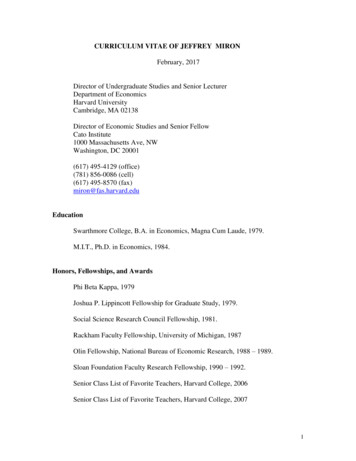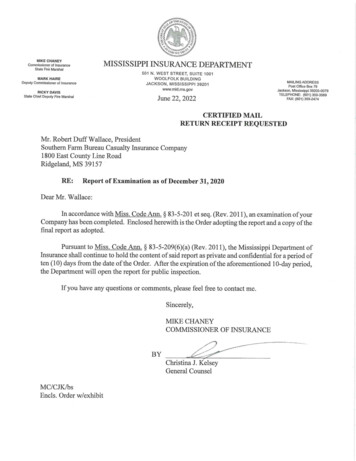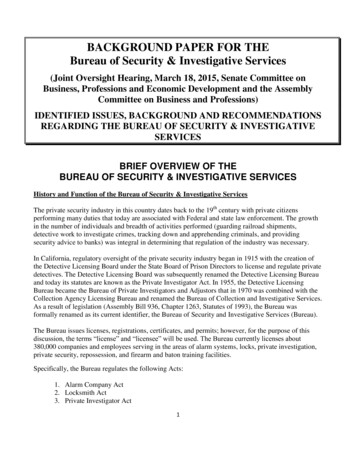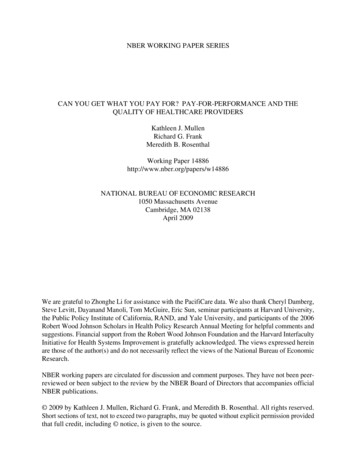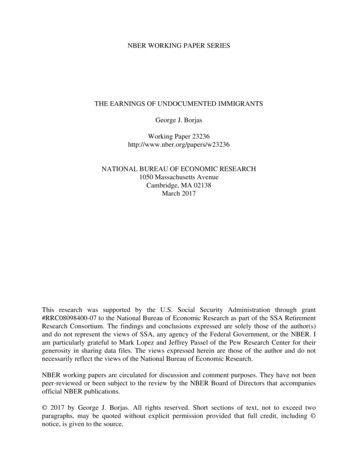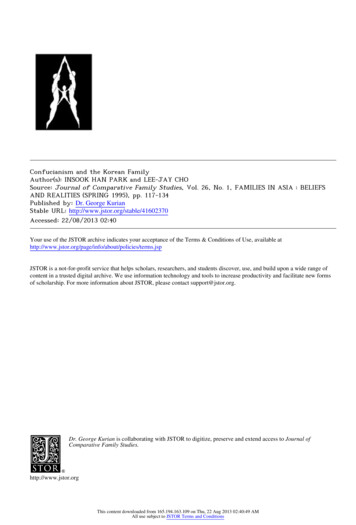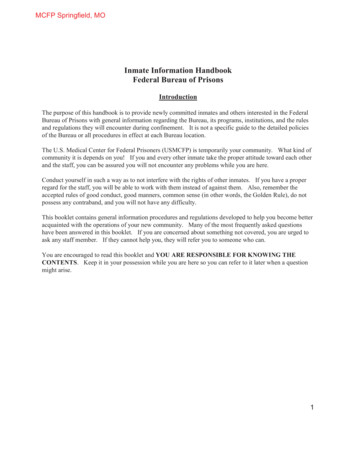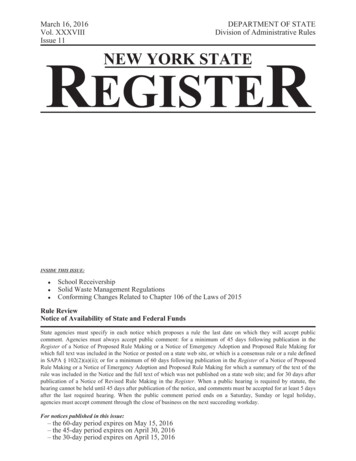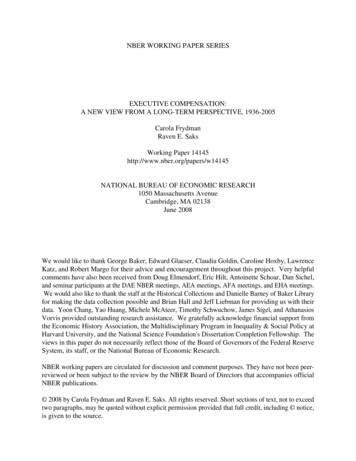
Transcription
NBER WORKING PAPER SERIESEXECUTIVE COMPENSATION:A NEW VIEW FROM A LONG-TERM PERSPECTIVE, 1936-2005Carola FrydmanRaven E. SaksWorking Paper 14145http://www.nber.org/papers/w14145NATIONAL BUREAU OF ECONOMIC RESEARCH1050 Massachusetts AvenueCambridge, MA 02138June 2008We would like to thank George Baker, Edward Glaeser, Claudia Goldin, Caroline Hoxby, LawrenceKatz, and Robert Margo for their advice and encouragement throughout this project. Very helpfulcomments have also been received from Doug Elmendorf, Eric Hilt, Antoinette Schoar, Dan Sichel,and seminar participants at the DAE NBER meetings, AEA meetings, AFA meetings, and EHA meetings.We would also like to thank the staff at the Historical Collections and Danielle Barney of Baker Libraryfor making the data collection possible and Brian Hall and Jeff Liebman for providing us with theirdata. Yoon Chang, Yao Huang, Michele McAteer, Timothy Schwuchow, James Sigel, and AthanasiosVorvis provided outstanding research assistance. We gratefully acknowledge financial support fromthe Economic History Association, the Multidisciplinary Program in Inequality & Social Policy atHarvard University, and the National Science Foundation's Dissertation Completion Fellowship. Theviews in this paper do not necessarily reflect those of the Board of Governors of the Federal ReserveSystem, its staff, or the National Bureau of Economic Research.NBER working papers are circulated for discussion and comment purposes. They have not been peerreviewed or been subject to the review by the NBER Board of Directors that accompanies officialNBER publications. 2008 by Carola Frydman and Raven E. Saks. All rights reserved. Short sections of text, not to exceedtwo paragraphs, may be quoted without explicit permission provided that full credit, including notice,is given to the source.
Executive Compensation: A New View from a Long-Term Perspective, 1936-2005Carola Frydman and Raven E. SaksNBER Working Paper No. 14145June 2008JEL No. G30,J33,M52,N82ABSTRACTWe analyze the long-run trends in executive compensation using a new panel dataset of top executivesin large publicly-held firms from 1936 to 2005, collected from corporate reports. This historic perspectivereveals several surprising new facts that conflict with inferences based only on data from the recentdecades. First, the median real value of compensation was remarkably flat from the end of WorldWar II to the mid-1970s, even during times of rapid economic expansion and aggregate firm growth.This finding contrasts sharply with the steep upward trajectory of pay over the past thirty years, whichcoincided with a period of similarly large increases in aggregate firm size. A second surprising findingis that the sensitivity of an executive's wealth to firm performance was not inconsequentially smallfor most of our sample period. Thus, recent years were not the first time when compensation arrangementsserved to align managerial incentives with those of shareholders. Taken together, the long-run trendsin the level and structure of compensation pose a challenge to several common explanations for thewidely-debated surge in executive pay of the past several decades, including changes in firms' size,rent extraction by CEOs, and increases in managerial incentives.Carola FrydmanMIT Sloan School of Management50 Memorial DriveE52-436Cambridge, MA 02142and NBERfrydman@mit.eduRaven E. SaksU.S. Federal Reserve – Division of Research and St20th and C Streets NWWashington, DC 20551raven.e.saks@frb.gov
1. IntroductionThe compensation paid to CEOs of large publicly-traded corporations rose dramatically duringthe 1980s and 1990s, stimulating much debate on the determinants of managerial pay (Murphy1999, Hall and Murphy 2003). The discussion has been largely inconclusive, due partly to theshort time span of available data. By constructing a new long-run time series of executive paywe are able to analyze the trends in the level and composition of pay over most of the twentiethcentury.This new dataset allows us to differentiate between some of the most popularexplanations for the recent surge in compensation: managerial rent-seeking, a competitive labormarket for executives, and increases in managerial incentives.To document the long-run trends in pay we hand collected a comprehensive panel dataseton the compensation of individual executives based on proxy statements and 10-K reports from1936 to 2005. Although our sample is mainly composed of executives employed in the largestcorporations in the economy, our results are broadly characteristic of the largest 300 publiclytraded firms.The data from earlier decades reveal several surprising facts that go against the currentview of top executive pay, which is primarily based on data from recent decades.First,executive compensation was remarkably flat from the end of World War II to the mid-1970s, atime in which firms grew rapidly. This stability contrasts sharply with the evidence from the1980s to the present, when executive pay and firms expanded at almost the same rate. Thus, thestrong correlation between executive compensation and the aggregate market value of firmsdocumented in recent decades (Hall and Murphy 2003, Jensen and Murphy 2004, Gabaix andLandier 2008) was much smaller prior to the mid-1970s.1
A second finding that is surprising in light of inferences based on more recent data is thatstock option grants have been an important part of the compensation package since the 1950s.Even though the value of option grants was low prior to the 1980s, executives have owned asubstantial number of stock options for the past 50 years. Using a measure of an executive’sfirm-related wealth that includes changes in the value of his holdings of stock and stock options,we calculate consistent measures of the correlation between wealth and firm performance (oftencalled “pay-to-performance”) over the past 70 years.We confirm that this relationshipstrengthened considerably from the 1980s to the present (Hall and Liebman 1998, Murphy1999). However, this increase was not part of a long-run upward trend. The sensitivity ofchanges in wealth to performance was about the same in the 1930s, 1950s and 1960s as it was inthe 1980s, but somewhat lower in the 1940s and 1970s. Although accurate for the 1970s, Jensenand Murphy’s (1990) view that CEOs were paid as bureaucrats was not generally true in the past.The strength of the incentives provided by these correlations is difficult to assess, but we findthat the magnitude of the correlation for most of our sample was not inconsequentially small.Throughout most of the twentieth century, the wealth of an executive would have increased by30 to 60 percent if she had been able to raise the firm’s rate of return from the 50th to the 70thpercentile of firm performance.Thus, recent decades were not the first period in whichcompensation arrangements generated a strong link between the executives’ wealth and firmvalue.Although a comprehensive analysis of the causes of these trends is beyond the scope ofthe present paper, the long-run data provide new evidence to evaluate some of the majorhypotheses for the recent surge in executive compensation. First, the run-up in CEO pay and theexpanded use of stock options have been linked to managers’ ability to extract rents from the2
firm (Bebchuk and Fried 2003, Bebchuk and Fried 2004, Kuhnen and Zwiebel 2007). However,both the level of pay and the use of options were lower from the 1950s to the 1970s than in morerecent years, even though corporate governance was arguably weaker in the earlier period. Thus,this explanation does not seem to fit well with the changes in executive pay over time.A second set of explanations relate executive pay to changes in firm size. High levels ofpay may be the result of firms’ competition for scarce managerial talent (Lucas 1978, Rosen1981, Rosen 1982, Tervio 2007), leading to higher compensation in larger firms. Consistentwith this prediction, the cross-sectional correlation between the level of pay and a firm’s positionin the distribution of firm size was about 0.3 for most of our sample period. Extensions of thistheory also predict that compensation should rise along with increases in the size of the typicalfirm in the market (Gabaix and Landier 2008). However, we find that shifts in the distribution offirms’ market values over time were only weakly correlated with compensation prior to the mid1970s, casting doubt on the validity of this theory for earlier time periods. In addition, theappearance of a strong correlation in more recent decades may be spurious, suggesting that thismodel may not even explain the post-1970 growth in executive pay.Another explanation for the high level of pay in recent years is the need to compensateexecutives for the risk generated by a greater use of incentive pay since the 1980s.1 However,we find a considerable sensitivity of managerial wealth to firm performance in the 1950s and1960s and much weaker incentives in the 1970s without notable changes in the level of pay.Thus, changes in pay-to-performance were not always accompanied by changes in the level ofcompensation.1The optimal sensitivity of managerial wealth to firm performance may have increased in recent decades due torising business risk (Inderst and Mueller 2006) or greater international competition (Cuñat and Guadalupe 2006)3
It seems unlikely that these explanations can account for the long-run trends that wedocument in this paper, suggesting that the major determinants of pay may have changed overtime. It is possible that the labor market for corporate executives operated differently in the past.Other factors, such as improvements in board monitoring and changes in social norms, may alsohave altered compensation arrangements.Thus, further studies of executive compensationshould address these long-run trends to improve our understanding of how the determinants ofpay have evolved over time.2. Executive compensation dataA large fraction of the empirical research on executive compensation has focused on the periodafter 1992 because data on managerial pay since that date are easily available in Compustat’sExecutive Compensation database (ExecuComp).The sources of these data are the proxystatements of publicly-held corporations, which report the remuneration of the firm’s highestpaid officers.Although ExecuComp does not start until 1992, the SEC has had similardisclosure requirements since its inception in 1934.2 Thus, we construct a long-run panel dataseton executive compensation by hand-collecting data for the years 1936 to 1991 from historicalproxy statements and 10-K reports, and using ExecuComp from 1992 to 2005.3 Althoughdisclosure requirements have evolved over time, firms’ corporate reports provide sufficientlydetailed information to allow us to track executive pay in a consistent manner over the longer2Corporations were required to disclose the compensation of top officers in 10-K reports starting in 1934, but manyfirms were reluctant to do so in the early years. By 1936 most of the firms included data on remuneration in thesereports, and so we start our sample in that year.3Studies that have used proxy statements to study executive pay prior to1992 (although over shorter time periodsthan our sample) include Baker (1938), Roberts (1959), Lewellen (1968), Wattel (1978), Murphy (1985), Yermack(1995), and Hall and Liebman (1998). Due to differences in sample design and in the methodologies used to valuethe components of pay, these data cannot be used to provide a consistent description of the long-run evolution ofpay.4
run.4These data are particularly important for constructing consistent measures of stock optionuse, because options were valued differently in research conducted prior to the 1970s than thecommon practice today.To construct our dataset, we select the largest 50 publicly-traded corporations in 1940,1960 and 1990. We identify the largest firms in 1960 and 1990 by ranking corporations inStandard & Poor’s Compustat database according to their total value of sales. Compustat’s datado not extend back to 1940, so for that year we rank firms in the Center for Research in SecurityPrices (CRSP) database according to their market value.5 Because some firms appear among thelargest 50 in more than one year, our dataset covers a total of 101 companies. For each firm, wecollect annual data on the pay of the top officers for as many years as our sources allow. When afirm in our sample merges with a firm outside of the sample, we continue to follow theexecutives in the merged firm if the new firm retains the same name or if the industrialclassification of the new firm does not change (see Appendix Section 1.1 for details). Theresulting dataset is an unbalanced panel as companies enter and leave the sample over time.6About 75 percent of the firms in our sample are in manufacturing industries, but ourdataset also contains communications, public utilities, and retail companies. Appendix Table A1lists all of the firms in our sample and Appendix Table A2 shows the distribution of firms by 2digit SIC code.4Not only do these documents report information on salaries, bonus payments, stock options, and stock holdings,but they also contain detailed descriptions of compensation plans that allow for consistent measurement of eachcomponent of pay over time.5The considerable size of the data collection effort caused us to select a small number of firms based on rankings inthree particular years. However, our intention was to select companies that were large for a reasonable period oftime. Therefore, we use the value sales to measure firm size whenever possible, since it is less susceptible totransitory shocks than market value. A detailed description of the sample design is provided in the Data Appendix.6Firms enter the sample when they go public or when corporate records become available in the collection at theBaker Library of Harvard Business School (our main source of corporate reports). Companies exit the sample asthey go bankrupt, become private, or are acquired by a foreign firm, among other reasons.5
Because our dataset includes firms that were large at different points in time, it capturessome of the structural changes that were experienced by the economy over this 70-year period.Although this sample is not representative of the economy as a whole, it comprises at least 20percent of the market value of the S&P 500 in every decade, and more than 40 percent prior to1970 (see Appendix Table A3). Because the sample includes all of the available years for eachof the selected firms, it reflects a broader segment of the economy than the largest 50 publiclytraded firms alone. We discuss the representativeness of our sample in Appendix Section 3, andconclude that it is representative of the largest 300 publicly-traded corporations. On the otherhand, the sample does not reflect the compensation practices of smaller or private firms.Table 1 reports basic descriptive statistics of our main sample, which includes the threehighest-paid officers in each firm.7 There are more than 15,800 executive-year observationsbetween the years 1936 to 2005, for a total of 2,862 individuals. The job titles held by theexecutives in our sample suggest that these officers were the main decision-makers in the firm(see Table 2). More than 47 percent of these managers held the title “CEO,” “president,” or“chairman of the board.”8 Furthermore, more than 80 percent of these officers also served on theboard of directors.3. Long-Run Trends in Compensation3.1 Trends in total compensation7Although we collected data on the five highest-paid officers in each firm whenever possible, corporate reportsconsistently listed only the three highest-paid officers prior to 1978. We limit our analysis to the top three officersin order to maintain a consistent group of individuals over time, but the results are robust to including the 4th and 5thhighest-paid executives.8Restricting the analysis to CEOs is useful for comparing our sample to previous research, which has mainlyfocused on chief executive officers. Because the term “CEO” was not frequently used until the 1970s, identifyingwho held this title is not always straightforward. Previous studies suggest that this person was most often thepresident of the company, so we identify the president as the chief executive where the CEO is not explicitlymentioned (Mace 1971). In cases where we observe neither a CEO nor a president, we identify the chairman of theboard as the CEO (about 2 percent of the observations).6
Figure 1 shows the median real value of total compensation from 1936 to 2005.9 We define totalcompensation as the sum of salaries, bonuses, long-term incentive payments, and the BlackScholes value of stock option grants. The figure reveals three distinct phases that form a Jshaped pattern over the course of our sample period. During the first 15 years, the real value ofcompensation fell from about 0.9 million to 0.75 million. Although more pronounced duringWorld War II, the decline in executive pay continued from the end of the war until the early1950s. This period of deterioration was followed by 25 years of slow growth, averaging 0.8percent per year from 1950 to 1975. Finally, the level of executive pay has climbed at anincreasing rate since the mid-1970s. Although compensation dipped briefly from 2001 to 2003,it resumed a rapid rate of growth during the last two years of our sample. Thus, the rapidincrease in pay in the 1990s did not end with the collapse of the stock market boom in 2000.More than 95 percent of the individuals in our sample fall above the 99.9th percentile ofthe national distribution of wage and salary income documented by Piketty and Saez (2003).Therefore, a comparison of executive pay to the earnings of a typical worker provides insightinto the evolution of earnings inequality at the top of the income distribution. We calculaterelative executive pay by dividing median compensation in our sample by average earnings perfull-time equivalent worker from the National Income and Product Accounts.This measure of earnings inequality follows an even-more pronounced J-shaped patternover our sample period than the dollar value of executive pay (see the dashed line in Figure 1).The real value of average earnings in the economy increased during the early years of our sampleeven as the level of executive pay declined, leading to a sharp contraction in the gap betweenthese two groups from 1940 to 1944. Relative executive pay declined further until 1970, atwhich point executive earnings began to rise faster than those of the average worker. By 1990,9Throughout the paper, real values are measured in year 2000 dollars using the Consumer Price Index.7
relative executive pay had recovered its Depression-era level. The gap between executives andworkers expanded even further during the most recent 15 years, and by 2005 the medianexecutive in our sample earned 110 times average worker earnings—about twice thecorresponding ratio prior to World War II. Despite differences in the underlying source databetween our sample and the income tax records used by Piketty and Saez to calculate wage andincome shares, the trend in relative executive pay is similar to the share of the top 0.1 percent ofthe national distribution of wage and salary income.103.2 The structure of executive compensationFigure 2 decomposes the real value of total compensation into its three main components. Theshort dashed line shows the median value of salaries plus any bonus that was both awarded andpaid out within the same year, which we refer to as a current bonus.11 These bonuses weregenerally paid in cash, but some were also paid in company stock. The long-dashed line adds theamount paid to each executive as part of a deferred bonus or long-term incentive payment.12 Thesolid line, which replicates the real value of total compensation shown in Figure 1, adds theBlack-Scholes value of stock option grants.10Piketty and Saez use income tax records to estimate shares of aggregate wage and salary income. Onedisadvantage of income tax data is that they only contain information on the gains from exercising options. We usethe value of stock option grants, which reflects the value of pay at the time of the award more accurately, and are notaffected by subsequent movements in the firm’s share price or by the executive’s decision when to exercise theoptions. Moreover, the vast majority of employee stock options during the 1950s and 1960s were taxed as capitalgains, and so would not have been reported on income tax returns as wages and salaries. Rather, they would haveappeared as capital gains, but only upon the sale of the stock that had been purchased when the option wasexercised.11Although it would be useful to separate salaries from current bonus payments, many firms reported only the sumof the two prior to 1992. In firms that did report these payments separately between 1947 and 1991 (about 20percent of the sample in these years), the value of current bonus payments usually ranged between 20 and 45 percentof current pay, with no obvious trend. Therefore, grants of current bonuses do not appear to have followed the sameupward trend as the use of long-term pay (discussed below).12We measure bonuses as the amount received during the year rather than the amount awarded (to be paid in thefuture) for consistency, because Compustat and some earlier proxy statements do not report information on the valueof bonuses awarded.8
During the first twenty years of our sample, compensation was composed mainly ofsalaries and current bonuses. Although long-term bonuses were awarded to some executives asearly as the 1940s, they were not common enough to make a noticeable impact on median payuntil the 1960s.13 These long-term bonuses were usually based on the firm’s profits or netincome, with payment in cash or stock distributed in equal installments over a certain number ofyears.14 These bonuses became a greater share of compensation over time, reaching more than35 percent of total pay by 2005.Stock option grants have also become a larger fraction of compensation over the courseof our sample period. Among executives receiving an option award, the median value of grantsfluctuated between 15 and 30 percent of total compensation from the mid-1950s to the mid1980s. The upper end of this range is not much less than the median value of 37 percent duringthe option boom of the late 1990s, suggesting that options have been an important component ofexecutive pay since mid-century.15Because the value of an option award relative to the total pay of those executives beinggranted options has not risen greatly over time, the increasing importance of stock optionsrelative to median total compensation is largely due to an upward trend in the frequency ofgrants. The use of employee stock options was almost negligible during the 1930s and 1940s. In1950, tax reform legislation introduced the restricted stock option, a special type of option thatwas taxed as a capital gain instead of as labor income. Consequently, executives paid a marginal13The 1950s were not the first period when incentive compensation mechanisms were a part of managerial pay.Historical accounts suggest that both current and deferred forms of incentive compensation were almost negligibleprior to WWI but became commonly used during the 1920s (Taussig and Barker 1925, Baker and Crum 1935, Baker1938, Roberts 1959). With the onset of the Depression and large declines in firm profits, many bonus plans wereabandoned or suspended (Baker 1938).14The deferral period was generally around 5 years, although individual plans varied from 2 to 10 years.15The popular press also highlighted the significance of options as a form of executive remuneration during thisearlier period, with headlines such as “Option Opulence” (Wall Street Journal, Feb. 1 1955) and “Stock OptionsPopular” (New York Times, Mar. 26, 1958).9
tax rate on these options of only 25 percent instead of the 70 to 90 percent marginal rate theyfaced on labor income. More than 40 percent of the firms in our sample instituted a restrictedstock option plan in the 5 years following this reform, suggesting that this tax policy had asignificant impact on executive pay.Despite the proliferation of restricted stock option plans during this period, the awardsmade under these plans were sporadic at first. Throughout the 1950s, only about 16 percent ofthe executives in our sample were awarded an option in any given year. The frequency of stockoption grants has increased steadily since then.By the 1990s, the fraction of executivesreceiving an option had reached 82 percent (see Figure 3).Prior research on executive pay has found more infrequent option use during the 1970sand the early 1980s than we find in our sample (Hall and Liebman 1998, Jensen and Murphy2004, and Murphy 1999).16 The difference between our results and prior research can be partlyexplained by firm size. Our sample is more heavily weighted towards large firms than othersamples, and large firms tend to grant options more frequently. However, several measurementissues are also important in explaining these discrepancies. First, prior work on option use in the1970s has relied on data on the gains from exercising options rather than direct evidence onoption grants. In our data, the probability of being granted an option during the 1970s was 16percentage points higher than the probability of exercising an option, possibly due to poor stockmarket performance during this period.17 The high frequency of stock option grants in oursample is also related to the treatment of multi-year reporting of options. Many proxy statements16There is little evidence in prior research on the use of employee stock options prior to the 1970s. Lewellen (1968)provides a notable exception for the period 1940 to 1963. Although he claims that stock options were a much moreimportant share of executive pay than our data suggest, his method of valuing options is substantially different fromours and is likely biased upward. See Section 3.2 of the Appendix for details.17The downturn in the market made the repricing of options a common practice during the 1970s. We excluderepriced options from our estimates of grants whenever it is possible to identify them.10
issued from the late 1960s to the late 1980s reported option grants and exercises as 3- or 5-yearcumulative totals, making it difficult to ascertain the actual number granted or exercised in eachyear. While our treatment of multi-year reporting biases the frequency of grants upwards, theaverage and median values of options granted are unbiased. See Sections 2.2 and 3.2 of theAppendix for further details.3.3 Other forms of compensationOur analysis does not include information on two other components of pay: pensions andperquisites. Although proxy statements provide descriptions of pension plans, we are unable toestimate the value of these benefits because many plans were based on an age-tenure profile ofthe managers and we lack this information on most of the managers in our sample. We excludeperquisites because firms were not required to report any information on this type of pay until thelate 1970s.18The omission of pensions and perks may bias our estimate of the trend in totalcompensation because they are not subject to personal income taxes at the time they are awarded,so these methods of pay may have been more common in the 1950s and 1960s when tax rateswere particularly high.Thus, the growth rate in total pay (including both observed andunobserved forms of compensation) may have been faster during these earlier decades than inlater years when the tax advantage of pensions, perks, and other non-taxable benefits wassmaller.18Regulation introduced in 1978 required firms to disclose the total amount of remuneration distributed or accruedin the form of securities or property, insurance benefits or reimbursement, and personal benefits. Perquisites andother personal benefits (above a minimum threshold) have been separately reported since 1993. However, theaccuracy of data on perks is limited, and so most research has focused on whether a certain perk was offered ratherthan on its actual value (Rajan and Wulf 2006, Yermack 2006)11
On the other hand, evidence from Lewellen (1968) suggests that pensions cannot accountfor the low rate of growth in executive compensation observed during the 1950s and 1960s. Hereports that the after-tax value of retirement benefits was 15 percent of after-tax total pay from1950 to 1963. Because pensions were taxed at a lower rate than cash compensation, the pre-taxvalue of pensions relative to total pay was even lower than 15 percent. By contrast, Sundaramand Yermack (2006) find increases in the actuarial value of pensions to be about 10 percent oftotal CEO pay from 1996 to 2002, and Bebchuk and Jackson (2005) report a ratio of executives’retirement benefits to total pay received during their entire service as CEO of about 34 percent in2004. Thus, pensions do not appear to have been a larger fraction of total compensation in the1950s or 1960s than they are today.Furthermore, the following back-of-the-envelope calculation suggests that the combinedvalue of pensions, perquisites and other untaxed benefits would need to have been implausiblylarge to explain the low growth rate of pay during the 1950s and 1960s. For the observable typesof compensation in our dataset, median pay increased from 0.74 million in 1950 to 0.82million in 1970, an annual average growth rate of 0.5 percent. By contrast, median pay increasedby a factor of 4.4 from 1980 to 2000. If we assume that the value of unobserved forms of paywas zero in 1950, these unobserved benefits would need to have amounted to 2.4 million in1970 in order to achieve a rate of increase in tota
2. Executive compensation data A large fraction of the empirical research on executive compensation has focused on the period after 1992 because data on managerial pay since that date are easily available in Compustat's Executive Compensation database (ExecuComp). The sources of these data are the proxy
